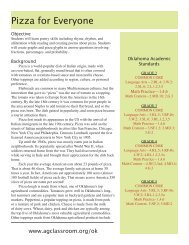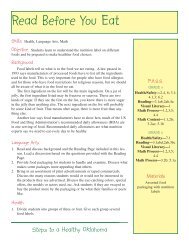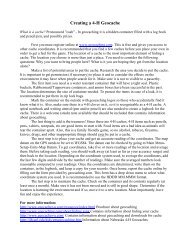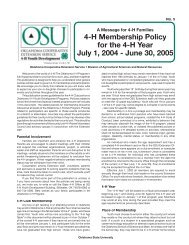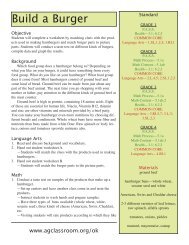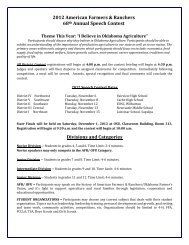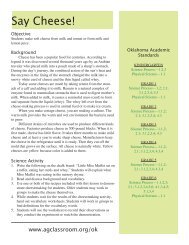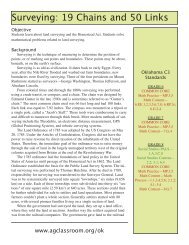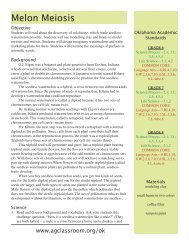You also want an ePaper? Increase the reach of your titles
YUMPU automatically turns print PDFs into web optimized ePapers that Google loves.
out that an object at rest, such as a rocket<br />
on a launch pad, needs the exertion of an<br />
unbalanced force to cause it to lift off. The<br />
amount of the thrust (force) produced by the<br />
rocket engines has to be greater than the<br />
force of gravity holding it down. As long as<br />
the thrust of the engines continues, the rocket<br />
accelerates. When the rocket runs out of<br />
propellant, the forces become unbalanced<br />
again. This time, gravity takes over and causes<br />
the rocket to fall back to Earth. Following its<br />
“landing,” the rocket is at rest again, and the<br />
forces are in balance.<br />
There is one very interesting part of<br />
this law that has enormous implications for<br />
spaceflight. When a rocket reaches space,<br />
atmospheric drag (friction) is greatly reduced<br />
or eliminated. Within the atmosphere, drag is<br />
an important unbalancing force. That force is<br />
virtually absent in space. A rocket traveling<br />
away from Earth at a speed greater than 11.186<br />
kilometers per second (6.95 miles per second)<br />
or 40,270 kilometers per hour (25,023 mph)<br />
will eventually escape Earth’s gravity. It will<br />
slow down, but Earth’s gravity will never slow it<br />
down enough to cause it to fall back to Earth.<br />
Ultimately, the rocket (actually its payload)<br />
will travel to the stars. No additional rocket<br />
thrust will be needed. Its inertia will cause it to<br />
continue to travel outward. Four spacecraft are<br />
actually doing that as you read this. Pioneers<br />
10 and 11 and Voyagers 1 and 2 are on<br />
journeys to the stars!<br />
Newton’s Third Law<br />
(It is useful to jump to the third law and come<br />
back to the second law later.) This is the law<br />
of motion with which many people are familiar.<br />
It is the principle of action and reaction. In<br />
the case of rockets, the action is the force<br />
produced by the expulsion of gas, smoke, and<br />
flames from the nozzle end of a rocket engine.<br />
The reaction force propels the rocket in the<br />
opposite direction.<br />
When a rocket lifts off, the combustion<br />
products from the burning propellants<br />
accelerate rapidly out of the engine. The<br />
rocket, on the other hand, slowly accelerates<br />
skyward. It would<br />
appear that something<br />
is wrong here if the<br />
action and reaction are<br />
supposed to be equal.<br />
They are equal, but<br />
the mass of the gas,<br />
smoke, and flames<br />
being propelled by<br />
the engine is much<br />
less than the mass<br />
of the rocket being<br />
propelled in the<br />
opposite direction.<br />
Even though the force<br />
is equal on both, the<br />
effects are different.<br />
Newton’s first law, the<br />
law of inertia, explains<br />
why. The law states<br />
that it takes a force to<br />
change the motion of<br />
an object. The greater<br />
the mass, the greater<br />
the force required to move it.<br />
Newton’s Second Law<br />
The second law relates force, acceleration, and<br />
mass. The law is often written as the equation:<br />
f = m a<br />
AC T ION<br />
REAC T ION<br />
The force or thrust produced by a rocket<br />
engine is directly proportional to the mass of<br />
the gas and particles produced by burning<br />
rocket propellant times the acceleration of<br />
those combustion products out the back of the<br />
engine. This law only applies to what is actually<br />
traveling out of the engine at the moment and<br />
not the mass of the rocket propellant contained<br />
in the rocket that will be consumed later.<br />
The implication of this law for rocketry<br />
is that the more propellant (m) you consume at<br />
any moment and the greater the acceleration (a)<br />
of the combustion products out of the nozzle,<br />
the greater the thrust (f).<br />
22




